May 2019 Independent Eating and Drinking Newsletter
| Independent Eating and Drinking are Wonderful |
 |
| May Newsletter Topics: |
|
| Subscribe to Newsletters |
How Constipation Affects Appetite
The clinical definition of constipation is that a bowel movement only occurs three times a week or less. Constipation can be acute or chronic. Some people are impacted by it constantly; for other people, it is an occasional occurrence. When someone is constipated, stools are hard and dry; and despite them being small relative to a normal stool, are hard to pass.
The gastrointestinal system is made up of a series of organs starting at the mouth, continuing through the esophagus, stomach, small intestine, large intestine (which includes the appendix, cecum, colon, and rectum), and the anus. The small intestines are responsible for absorbing the majority of the nutrients and liquid from food that has been digested in the stomach. When the remaining waste material passes into the large intestine it is solidified into a stool. The stool passes down the large intestine into the colon and into the rectum where it is stored prior to being excreted during a bowl movement. Constipation occurs when the stool remains in the rectum too long. Liquid is extracted from the stool and it becomes hard and dry. This consistency of stool is hard for the muscles of the rectum to push out through the anus.
There are many causes of constipation and it can affect people of all ages. Approximately 42 million, or around 15% of the U.S. population suffers from constipation. Common causes include a diet that is low in fiber (whole grains, vegetables, and fruits), lack of exercise, taking certain medications, neurological and metabolic disorders (spinal cord injury, Parkinson’s disease, diabetes, and thyroid disorders), and problems of the gastrointestinal tract (diverticulitis, colon polyps, tumors, and celiac disease). All of these can cause the processing of food by the body to slow down, and the result of this slowing is constipation.
Many people have what is known as functional constipation where they actually manage to have a bowel movement quite regularly but have to strain to expel the bowel movement, which is lumpy and hard, and they may not feel as if they have completely expelled everything in their rectum. However, this does not meet the definition of constipation despite the sufferer feeling as if they have problems.
Many cases of constipation can be mitigated by a change of diet. Most Americans do not eat enough fiber in their diet on a daily basis. Listed below are examples of how much fiber is contained in various foods:.
| Food Group | Serving Size | Fiber (g/serving) |
| Fruit | 0.5 Cup | 1.1 |
| Dark-green Vegetables | 0.5 Cup | 6.4 |
| Orange Vegetables | 0.5 Cup | 2.1 |
| Cooked Dry Beans (legumes) | 0.5 Cup | 8.0 |
| Starchy Vegetables | 0.5 Cup | 1.7 |
| Other Vegetables | 0.5 Cup | 1.1 |
| Whole Grains (bread, cereal, etc.) | 28 g (1 oz.) | 2.4 |
| Meat | 28 g (1 oz.) | 0.1 |
Exercise can also facilitate a reduction in the occurrence of constipation. Many people become constipated when they are unable to move around due to illness, surgery, pregnancy complications, etc., that limit the amount of movement that can be undertaken. Many people who are permanently limited in their ability to move, like those with spinal cord injuries, quadriplegia relating to cerebral palsy, etc., constipation can be an ongoing problem. It has been shown in recent studies that for those who sit in a wheelchair all day long, standing on a regular schedule can improve bowel regularity and reduce constipation (even if using the “stand” function of a power wheelchair, or a standing frame).
Medications are available to treat constipation. They include laxatives that help reduce constipation by forming bulk within the food that has been eaten which retains liquids and makes stools softer, bulkier, and easier to expel through the anus; and other laxatives that simply help the regular stool retain fluids and thus remain softer.
Complications can develop that are associated with straining to have a bowel movement due to constipation. Hemorrhoids occur when the veins around the anus and in the rectum become inflamed. They can bleed if they become very irritated. This will show as bright red blood on toilet tissue or in the toilet (internal bleeding from other parts of the body will be seen as black blood in the stool). There are over-the-counter treatments for hemorrhoids which include ointments or suppositories. However, if they do not respond to this treatment, medical help should be sought. Additionally, small tears can occur around the anus due to pushing to evacuate hard stools. They can be itchy and may also bleed. They can also be treated with over-the-counter medications but, if they persist, a physician should be consulted.
Chronic constipation is common among people who have severe disabilities whether their disabilities are congenital or acquired. It is important that when someone is aware of their need to have a bowel movement that they do not wait to relieve themselves. Waiting can increase the likelihood of constipation. For those who are not aware of when they need to have a bowel movement it is important that they maintain a regular bowel emptying schedule. Constipation can reduce appetite and significantly reduce mealtime enjoyment because food isn’t appealing when you are not hungry. Therefore, it is important that bowel function occurs regularly and without strain. For advice about regulating bowel function, talk to your physician.
| The Mealtime Partner Dining System | |
| For individuals who are unable to feed themselves because of limited or no hand and/or arm function, the Mealtime Partner provides them with a way to eat independently. This lets them experience an enjoyable mealtime that is totally under their control. They can choose what they eat for each bite and pace their eating to suit their own needs and desires. | |
|
|
|
| The
Mealtime Partner Dining System can be positioned to meet the
specific needs of each user. The user does not have to
adjust their position to eat using the device because the
Partner’s flexible mounting systems permit positioning to
fit the user's needs, making mealtimes a comfortable,
relaxed experience, with the user positioned safely
for eating. The Mealtime Partner empowers its user to eat what they want, when they want it. The Mealtime Partner Dining System is quick and easy to learn and has no complicated programming requirements. Each Dining System comes with a complete training video on DVD so new users and caregivers can learn to use it in just a few minutes. There are no other assistive dining systems that meet the needs of the users, like the Mealtime Partner. For more information about this device, click on this link. To talk to a representative, call us at 800-996-8607, or email us at: info@mealtimepartners.com and we will be happy to assist you in selecting the best system to meet your needs. |
The Very Versatile Front Mounted Drinking System
Mealtime Partners develops products to meet independent eating and drinking needs that are currently not satisfactorily fulfilled. An example of a previously unavailable product that was developed by Mealtime Partners is the Front Mounted Drinking System. Because, many people who are unable to pick up a drink with their hands also have a limited ability to suck, they require a short straw from which to drink (instead of a long drink tube). This reduces the mounting possibilities for a drinking system. The system must be in front of the user and near to their mouth. The Front Mounted Drinking System, is a drink holder that is positioned to hold a drink container (cup, bottle, 12 oz. can, etc.) close to the user's mouth. Thus, the straw can be as short as necessary to facilitate easy suction for the user. An additional benefit of the Front Mounted Drinking System is that it is the easiest to clean of all Mealtime Partners drinking systems. Many of the containers it holds are disposable and thus do not require cleaning. Those that do, are usually easy to wash or are dishwasher safe.
In the process of creating single purpose products, parts or components are often developed that are versatile enough to be used for more than one application. Our clamping products that were developed primarily to mount the Mealtime Partners drinking systems are an example of this. This article discusses the versatility of the Front Mounted Drinking System. However, when reading this article keep in mind that the Wheelchair Clamp used for this Drinking System can also be used in a wide variety of applications that do not necessarily relate to drinking.
The Front Mounted Drinking System is the most flexible of the drinking systems offered by Mealtime Partners. This is possible because it is a configuration of three components that are all adaptable: the Wheelchair Clamp, the Flex Arm, and the Cup Holder. The Front Mounted Drinking System is fundamentally a very versatile drink holder that can accommodate a variety of cups, cans, or bottles. It allows the drink to be held such that the drink tube (or straw) is very near the user's mouth. Thus the user can take a drink without using their hands with only a small amount of neck or upper body movement. Because the Clamp can be attached almost anywhere on the wheelchair and the Flex Arm can be bent to hold the Cup Holder in the desired position, the Front Mounted Drinking System becomes a semi-custom drinking system for each user.
Figure 1 below shows the Front Mounted Drinking System with a 30-inch Flex Arm mounted to the lower vertical support tubing of the wheelchair. The clamp is oriented horizontally on the tube. (The Front Mounted Drinking System can be purchased with 6-inch, 12-inch, 18-inch, 24-inch, or a 30-inch Flex Arm, as required to suit the needs of the user.)
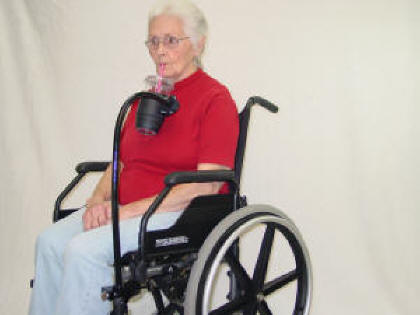 |
| Figure 1 - Front Mounted Drinking Systems Attached to Wheelchair |
To better understand how this system can be configured to accommodate the diverse needs of users, the three components used in the Front Mounted Drinking System will be discussed below.
The Wheelchair Clamp
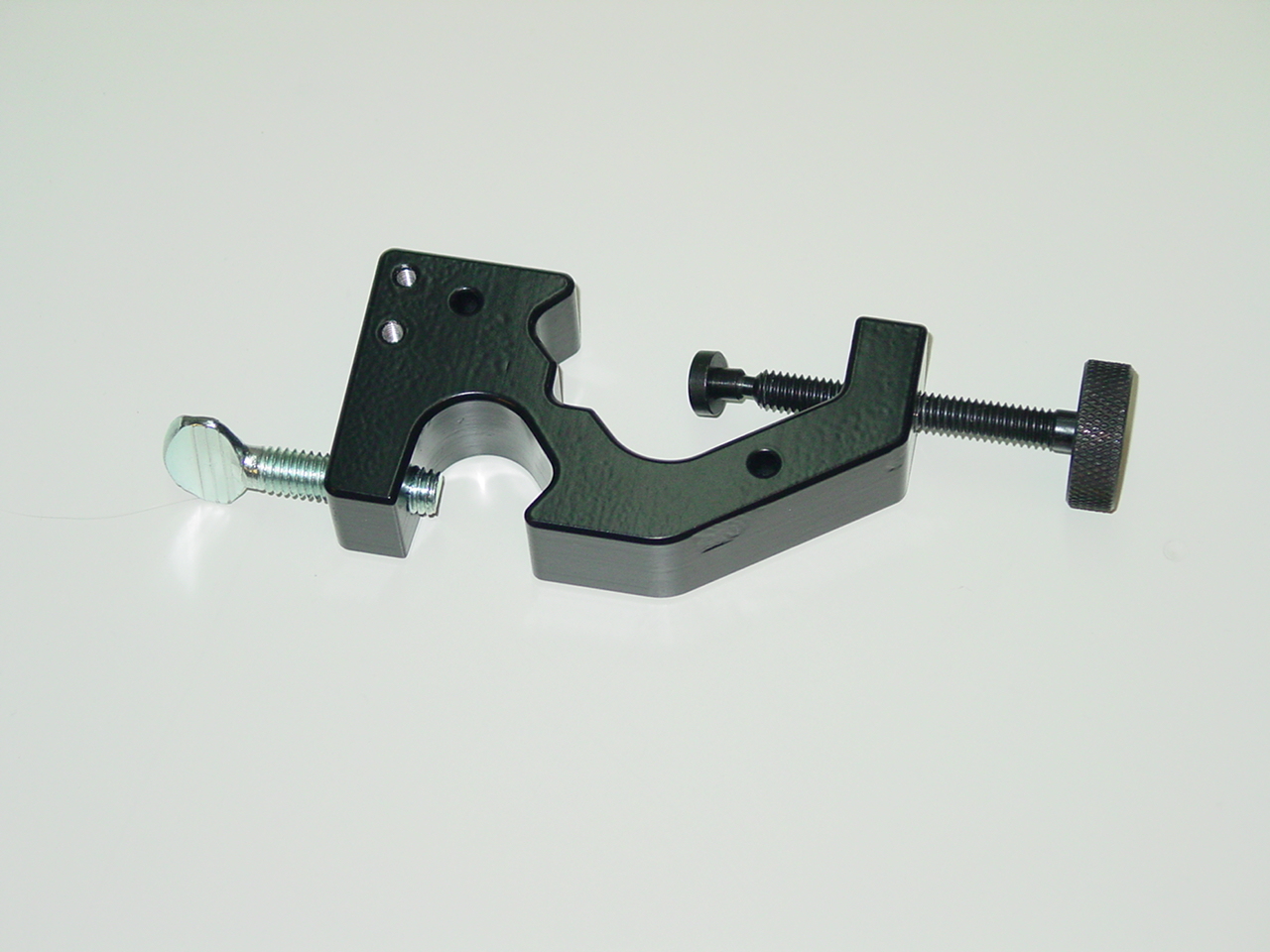 |
| Figure 2 - The MtP Wheelchair Clamp |
The Wheelchair Clamp, shown in Figure 2, can be attached to round (i.e., tubular), or square surfaces. The opening can accommodate round objects ranging from 3/8 inch to 1-1/4 inches in diameter, and flat objects from 3/8 inch to 1 3/4 inches in diameter. This allows attachment to a variety of structural parts on a wheelchair frame, a bed rail, or a table top. It can be clamped to both vertical and horizontal tubular or square rails. An integral part of the Wheelchair Clamp is its attachment holder which is opened and closed using a thumbscrew. The built in attachment holder can hold shafts from 11/16 inch to 7/8 inch. For the Front Mounted Drinking System that is pictured above, this attachment holder with associated Thumbscrew facilitates holding the Flex Arm securely in position.
Figure 3 shows examples of different locations and orientations that the Flex Arm can be mounted on a wheelchair using the Wheelchair Clamp.
|
|
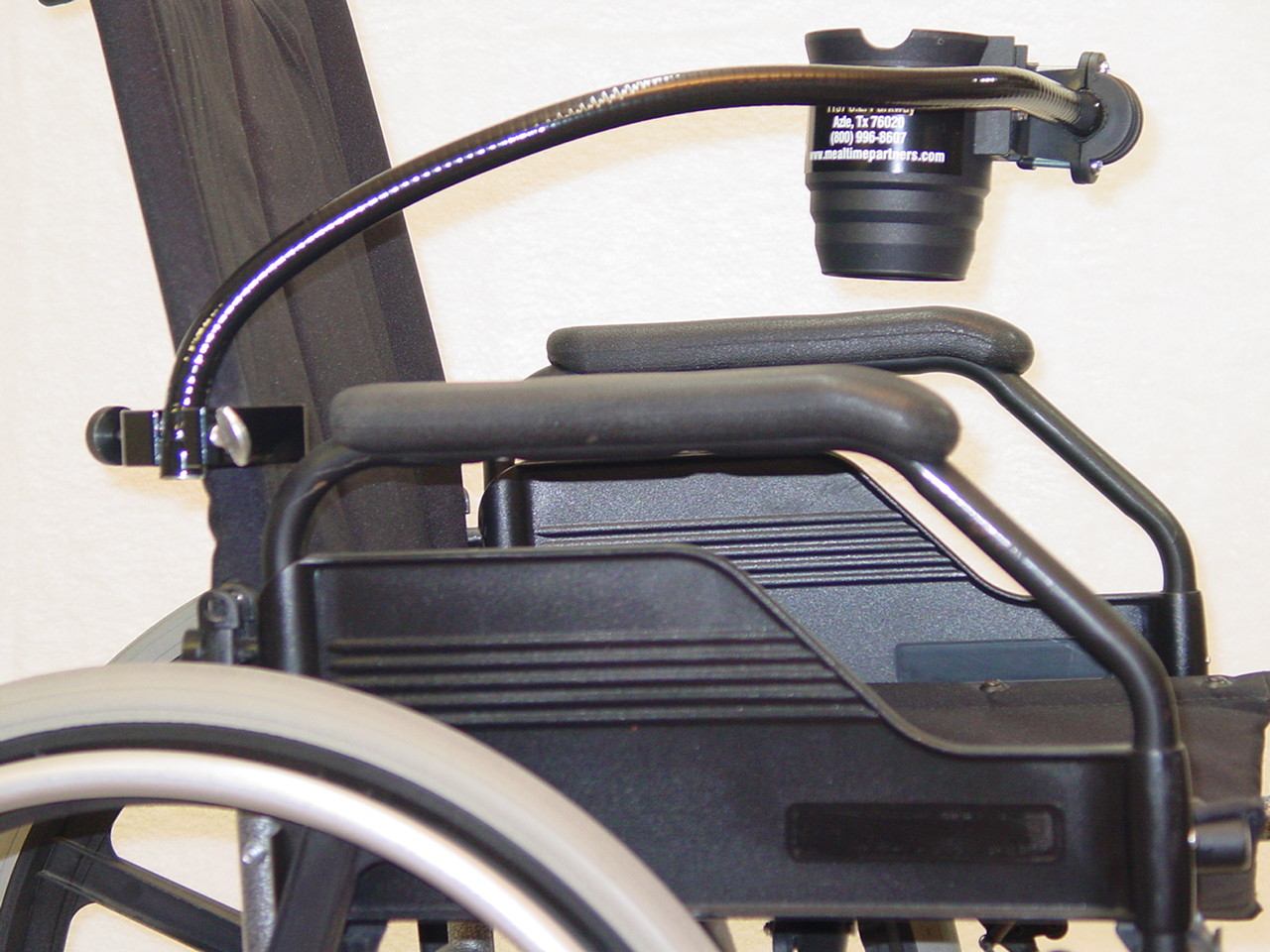 |
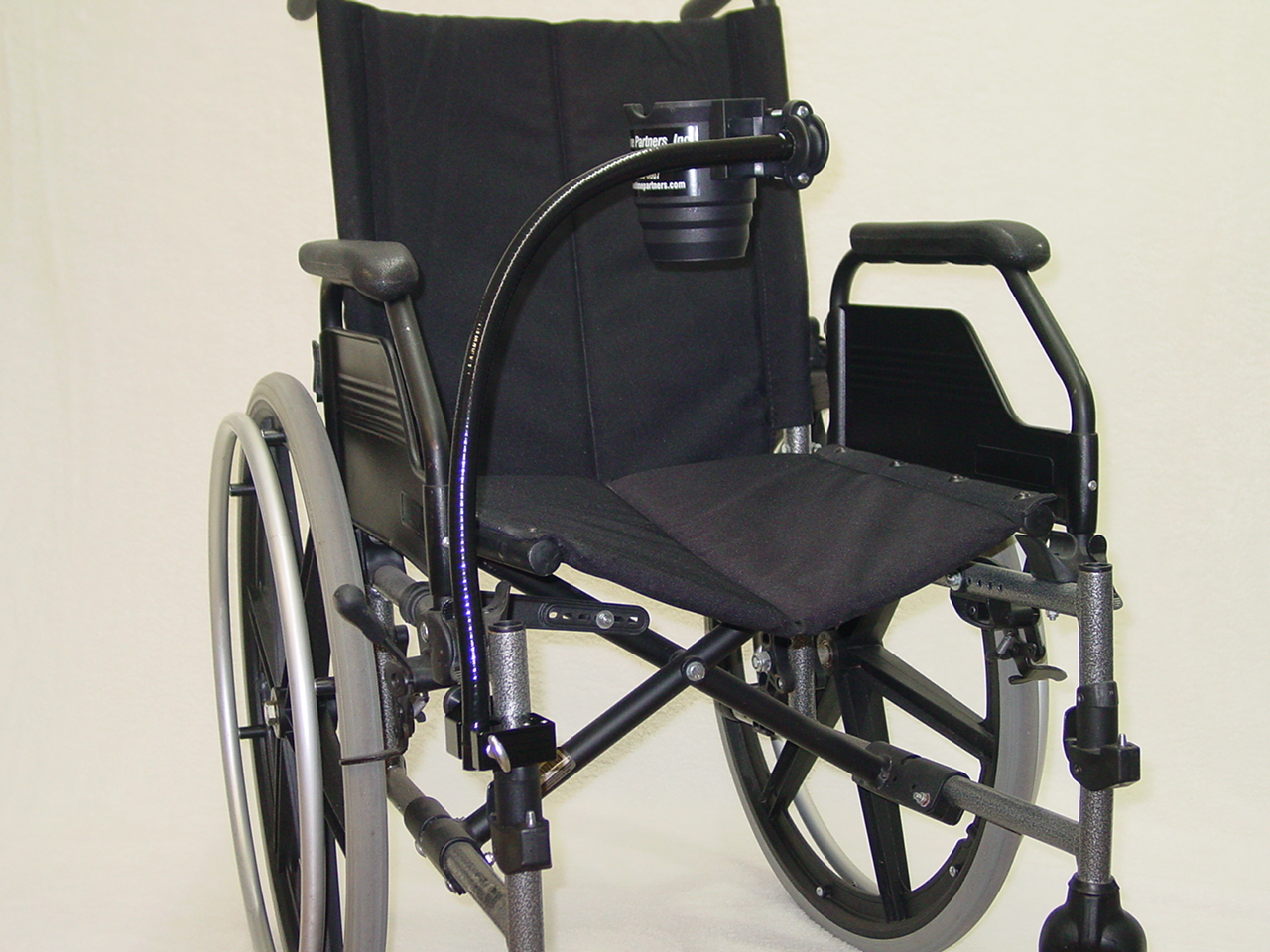 |
| Figure 3 - Examples of Methods of Attaching the Front Mounted Drinking System to a Wheelchair | ||
The Flex Arm
Mealtime Partners uses custom Flex Arms in many of their product assemblies. These Flex Arms are heavy duty, spring steel arms that have been chosen for their durability and capacity to maintain their position once they are positioned. Flex Arm (often referred to as flexible gooseneck tubing) can support an object and hold it in position. It is adjustable and can be re-positioned by bending. It is very rigid and will stay put after being re-positioned. The ends of the Flex Arm are solid shafts that are around 0.8-inch in diameter and 1-inch long so they can be clamped onto. Also, each end has a threaded hole (1/4"-20 thread), so objects can be screwed to it. Flex Arms are available in various lengths to accommodate different purposes. Currently Mealtime Partners provides products utilizing Flex Arms ranging from 6 inches in length to 30 inches in 6 inch increments.
The Cup Holder
The final essential component of the Front Mounted Drinking System is the Cup Holder. The Cup Holder attaches to the end of the Flex Arm and can be oriented in two directions, vertically or horizontally, as shown in Figure 4. Additionally, it should be noted that the Cup Holder has a cutout to accommodate the handle of a mug.
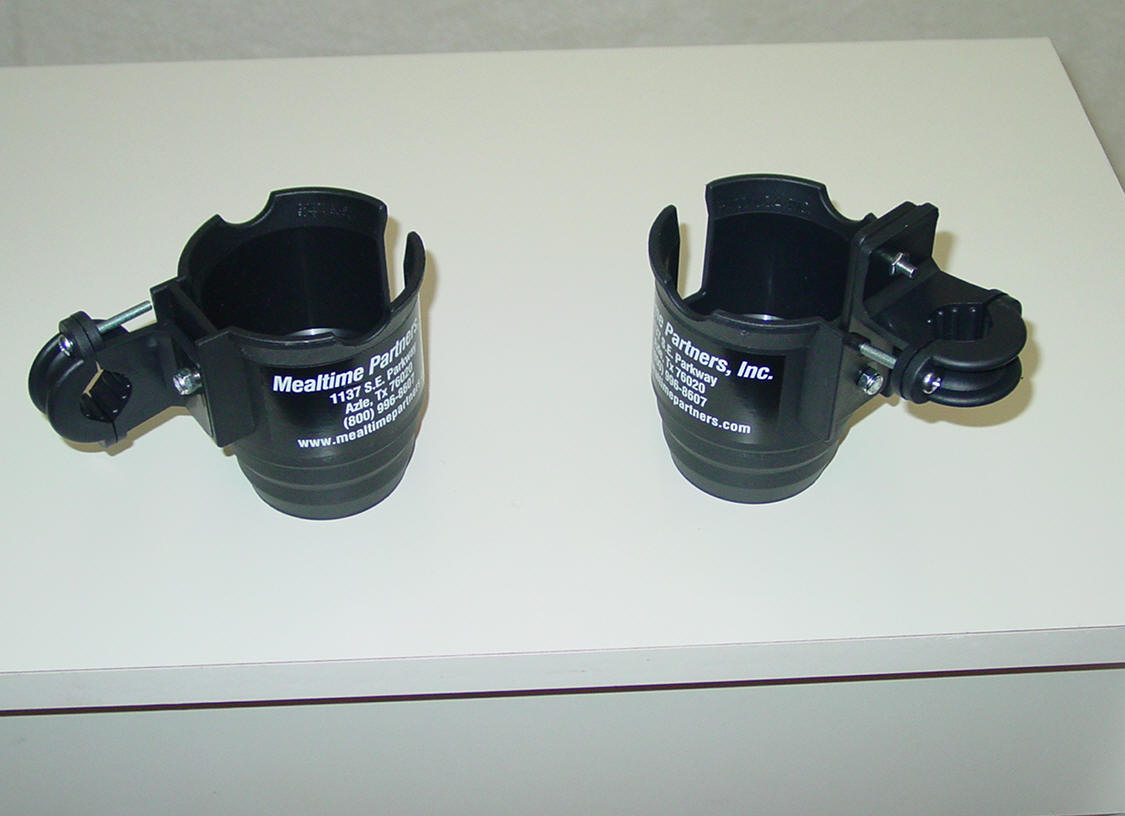 |
| Figure 4 - Cup Holders with attachment bracket mounted both horizontally and vertically. |
The Cup Holder can accommodate a wide variety of drink containers ranging from standard 12 oz. cans and coffee cups to large plastic cups which can be placed directly in the cup holder, and small cups like "Sippy Cups" that can be put in a koozie before being put in the cup holder.
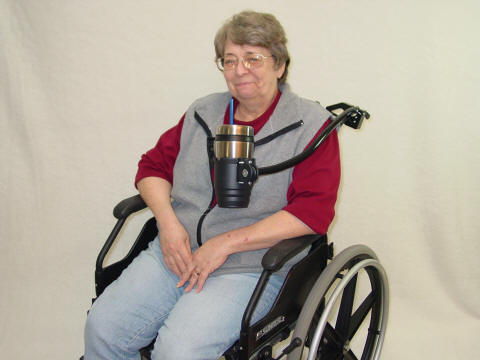 |
| Figure 5 - Front Mounted Drinking System with Coffee Cup |
A Koozie (which is provided with the Front Mounted Drinking System) can be inserted into the Cup Holder to position smaller cups snuggly (and to keep items hot or cold). Simply add a straw to the container and the drink is available.
In summary, the versatility of this drinking system allows it to be configured to meet the needs of a wide variety of users and make hydration easy and comfortable, even for individuals who lack the use of arms and/or hands. It requires the least suction of any drinking system currently available and is the easiest to clean because it can accommodate drink containers and straws that are disposable, or cups and bottles that can easily be removed and washed.
In next month's Newsletter, information will be provided about mounting the Front Mounted Drinking System onto wheelchairs that have slide-track mounting systems.
For assistance with selecting a hands-free drinking system, please contact Mealtime Partners at 800-996-8607 or info@mealtimepartners.com. We will; be pleased to assist you in your selection.
|
Did you know? Did you know that a study recently conducted by the National Institutes of Health found that a diet consisting of ultra-processed foods, as opposed to an unprocessed diet, leads to weight gain? Participants in the study ate a diet of ultra-processed foods for two weeks and a diet of unprocessed foods for two weeks. The calorie and nutrient content were matched in both diets. Participants could eat as much or as little of each meal as they chose. It was found that they consumed more calories when eating the untra-processed diet which led to a weight gain. During the time that they ate the unprocessed diet they consumed less calories and the result was a weight loss. The study findings indicate that if ultra-processed foods were eliminated, or greatly restricted in the diet it potentially could prevent obesity. The study findings are published in the journal: Cell Metabolism. |